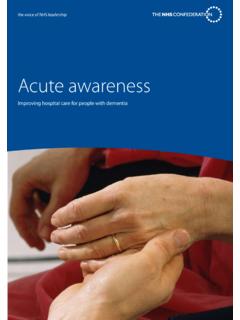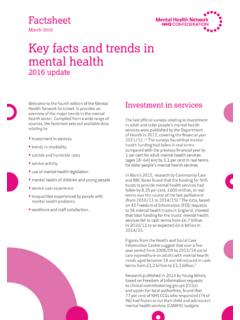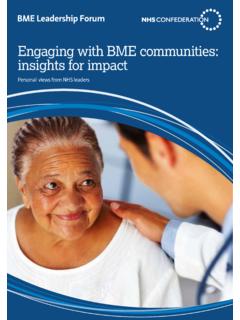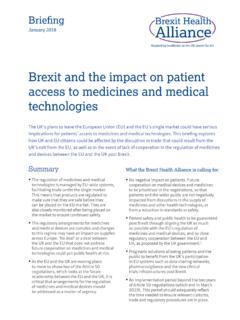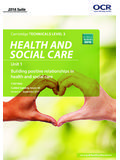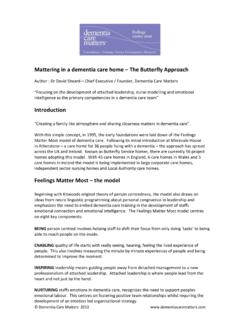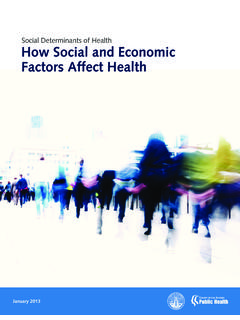Transcription of A primary care approach to mental health and …
1 A primary care approach to mental health and wellbeingCase study report on SandwellNHS reform and transitionThe NHS ConfederationThe NHS Confederation represents all organisations that commission and provide NHS services. It is the only membership body to bring together and speak on behalf of the whole of the NHS. We help the NHS to guarantee high standards of care for patients and best value for taxpayers by representing our members and working together with our health and social care make sense of the whole health system, influence health policy, support our members to share and implement best practice, and deliver industry-wide support functions for the The voice of NHS leadershipOur workIn consultation with our member policy forum, we have committed to focusing on key issues in 2012/13. Our work programmes are designed to ensure we are concentrating our efforts where our members need the most support as they strive to make the required efficiency savings and maintain and improve the quality of care while implementing the biggest reorganisation of the NHS in its history.
2 This report forms part of our work programme on NHS reform and transition. To read more about our work in this area, see more information on our work, please contact:The NHS Confederation 50 Broadway London SW1H 0 DBTel 020 7799 6666 Fax 0844 774 4319 Email Charity no. 1090329 Published by the NHS Confederation The NHS Confederation 2012 You may copy or distribute this work, but you must give the author credit, you may not use it for commercial purposes, and you may not alter, transform or build upon this Charity no: 1090329 BOK60055 ContentsExecutive summary 2 Introduction 3 Background 4 The drivers for change 6 The commissioning response 7 A collaborative primary care model for mental health and wellbeing 9 A stepped approach to provision 10 Learning points for implementation 17 Conclusion 19 Acknowledgements 20 References 21A primary care approach to mental health and wellbeing02 Executive summaryThe importance of mental health and wellbeing cannot be understated.
3 It affects and influences the lives of individuals, families, communities and societies. There is growing evidence that positive mental health and wellbeing at a population level can reduce health inequalities and improve wider outcomes in relation to physical health , social cohesion and economic productivity. This report presents a detailed case study of the journey Sandwell s health commissioners (then Sandwell PCT, now Sandwell and West Birmingham Clinical Commissioning Group) went through to respond to a number of important health inequalities within its local population. It focuses on how its health service commissioners responded to specific health inequalities to develop a primary care -led approach to improving mental health and wellbeing . The specific health inequalities they sought to address included: poor levels of mental and physical health social deprivation poor access to low-intensity community mental health and wellbeing services heavy use of secondary care mental health s primary care approach to mental health and wellbeing is a direct and practical response to stark health inequalities within its locality and challenges that many health service commissioners across England face.
4 The approach , known as the collaborative primary care model for mental health and wellbeing , uses the principles of collaboration, co-location and integration to support its population to access low-intensity services and healthcare professionals when making referrals. The purpose of each low-intensity service is to empower the population to make decisions about their own care and improve emotional resilience and wellbeing . 02 The approach also illustrates how early intervention and prevention, through a stepped approach to provision, can improve existing service Sandwell primary care approach to mental health and wellbeing has shown some promising early outcomes, with over 4,000 people completing prevention, wellbeing and health improvement programme, saving around 800,000 in prevention costs. In addition, over 3,000 people have accessed talking therapies, saving around 600,000. It provides some key learning points for wider commissioners to consider, namely: the continued need to align primary healthcare with key partners and stakeholders, including probation services, secondary care acute and mental health providers, schools, libraries and colleges the importance of investing in education and training for primary care and community care staff the importance of clinical and service user engagement.
5 Under new commissioning arrangements ushered in by the health and Social care Act (2012), the Sandwell example highlights the need to respond to strong evidence of local health inequalities. At a local level, clinical commissioning groups (CCGs) along with health and wellbeing boards may wish to utilise the evidence within joint strategic needs assessments to drive a primary care -led approach to mental health and wellbeing services. At a national level, the NHS Commissioning Board and Public health England will need to work together to enable this type of local innovation and priority setting. A primary care approach to mental health and wellbeing0303 IntroductionThere is growing evidence that positive mental health and wellbeing at a population level can reduce health inequalities and improve wider outcomes in relation to physical health , social cohesion and economic productivity. This case study report illustrates the vital role that health commissioners can play in ensuring mental health and wellbeing services are accessible, meet local needs and drive collaborative working.
6 It presents a detailed case study of the journey that Sandwell s health commissioners (then Sandwell PCT, now Sandwell and West Birmingham Clinical Commissioning Group) went through to respond to a number of important health inequalities within its local population. These include poor levels of mental and physical health , social deprivation, poor access to low-intensity community mental health and wellbeing services and heavy use of secondary care mental health services. The report focuses on four specific aspects of Sandwell s story: 1. The demographic context and drivers the specific health inequalities that prompted the development of a primary care -led approach to mental health and wellbeing and its priorities. 2. The collaborative primary care model that Sandwell s health service commissioners adopted to address the challenges. 3. The service infrastructure that has been developed to make the model a reality and work across a whole population while meeting individual The learning points from the implementation of the model for other commissioners.
7 There is growing evidence that positive mental health and wellbeing at a population level can reduce health inequalities and improve wider outcomes in relation to physical health , social cohesion and economic productivity. A primary care approach to mental health and wellbeing04 The Government s mental health strategy, No health without mental health , describes mental wellbeing as [a] positive state of mind and body, feeling safe and able to cope, with a sense of connection with people, communities and the wider environment. It affects the lives of individuals, families, communities and societies, and influences individual behaviour, wider social cohesion, social inclusion and economic Positive mental wellbeing also improves overall physical health , encourages recovery more rapidly and promotes higher levels of employment and Psychological wellbeingA growing amount of research has explored the benefits of positive psychological states such as contentment and fulfilment,3 often collectively referred to as psychological wellbeing .
8 Far from being associated with the absence of mental health difficulties, psychological wellbeing has distinct causes and significant implications across a range of wider outcome areas. For example, people who report higher levels of wellbeing tend to be more involved in social and civic life, are more likely to behave in environmentally responsible ways, have better family and social relationships at home and are more productive at work. In addition, a recent review of literature has found that wellbeing is positively associated with positive health outcomes. In response to the growing body of evidence in the area, the Department of health launched the coalition Government s mental health outcomes strategy, No health without mental health (2011). The strategy emphasised an important shift in policy, giving considerable attention to promoting positive and more preventative approaches for mental health and wellbeing across populations. The strategy also made mental wellbeing a priority for public mental s socio-economic landscapeA metropolitan borough located within the West Midlands, Sandwell is comprised of six towns; Oldbury, Rowley Regis, Smethwick, Tipton, Wednesbury and West Bromwich.
9 It is also the 14th most deprived local authority in England with 53 per cent of its wards described as very deprived (as of 2011). The borough has some important socio-economic contexts in its population, such as: around 23 per cent of residents are from black and minority ethnic (BME) groups, specifically of South Asian origin (Indian, Pakistani backgrounds)5 the area has a high unemployment figure at per cent, compared to the England average of 3 per cent (as of 2010) this is due to the decline in manufacturing in the past decade, which saw the number of jobs in the region fall by 13 per cent, compared with a 7 per cent fall nationally it has higher-than-average Job Seeker Allowance (JSA) claimants rates in comparison with regional and national levels this includes higher overall unemployment (including those not claiming benefit) and lower economic activity rates the borough has higher than average levels of non-decent homes and people per 1,000 households receive statutory homeless status (as of 2010).
10 BackgroundA primary care approach to mental health and wellbeing05 Physical healthThe physical health of people in Sandwell is also generally worse than the England Life expectancy for both men and women is lower than the England average. In the most deprived areas of Sandwell, life expectancy for men is years lower than in the least deprived areas. For women, it is years lower. Over the last ten years, all-cause mortality rates have fallen. Early death rates from cancer, heart disease and stroke have fallen, but remain worse than the England average. per cent of year 6 children are classified as obese. A lower percentage than average of pupils in Sandwell spend at least three hours each week on school sport. Levels of teenage pregnancy and GCSE attainment are worse than the England average. Estimated levels of adult healthy eating , smoking and obesity are worse than the England average. Rates of smoking-related deaths and hospital stays for alcohol-related harm are higher than the evidence for change In 2006, Sandwell primary care Trust, currently in transition to Sandwell and West Birmingham Clinical Commissioning Group, undertook a mental health GP profiling assessment.


